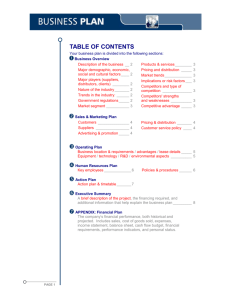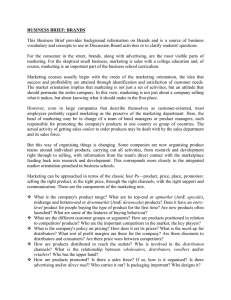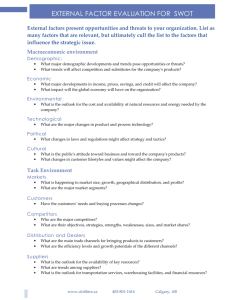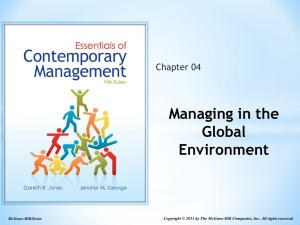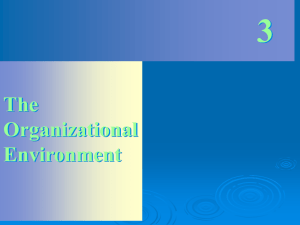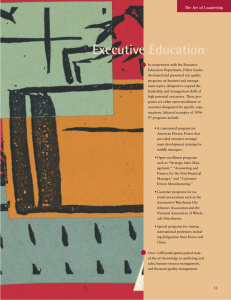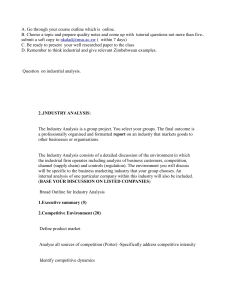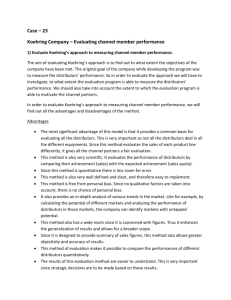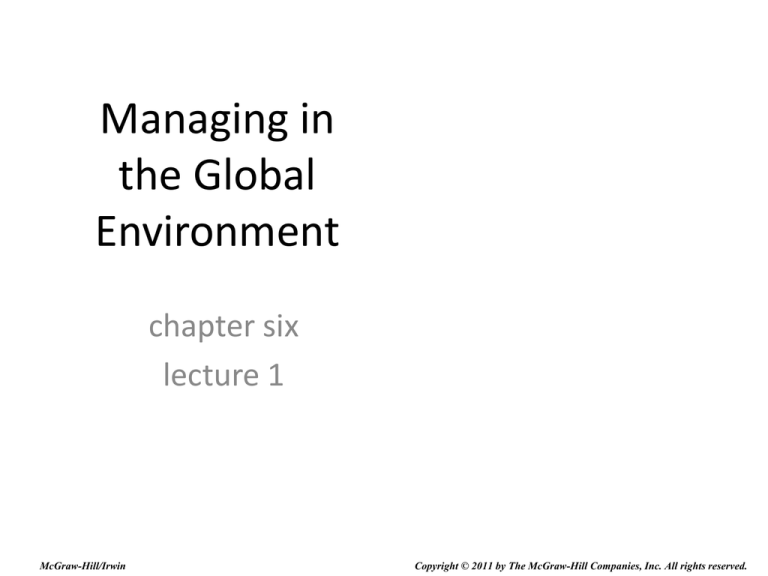
Managing in
the Global
Environment
chapter six
lecture 1
McGraw-Hill/Irwin
Copyright © 2011 by The McGraw-Hill Companies, Inc. All rights reserved.
Learning Objectives
1. Explain why the ability to perceive, interpret, and
respond appropriately to the global environment is
crucial for managerial success
2. Differentiate between the global task and global
general environments
3. Identify the main forces in both the global task and
general environments, and describe the challenges
that each force presents to managers
6-2
Learning Objectives (cont.)
4. Explain why the global environment is becoming
more open and competitive and identify the forces
behind the process of globalization that increases
the opportunities, complexities, challenges, and
threats that managers face
5. Discuss why national cultures differ and why it is
important that managers be sensitive to the effects
of falling trade barriers and regional trade
associations on the political and social systems of
nations around the world
6-3
Global Organizations
• Global Organizations
– Organizations that operate and compete not only
domestically, but also globally
– Uncertain and
unpredictable
6-4
What Is the Global Environment?
• Global Environment
– Set of forces and conditions in the world outside
the organization’s boundaries that affect the way
it operates and shape its behavior
– Changes over time
– Presents managers with opportunities and threats
6-5
Forces in the Global Environment
Figure 6.1
Page 212
6-6
What Is the Global Environment?
• Task Environment
– Set of forces and conditions that originate with
suppliers, distributors, customers, and
competitors
– Affects an organization’s ability to obtain inputs
and dispose of its outputs
– Most immediate and direct effect on managers
6-7
What Is the Global Environment?
• General environment
– The wide-ranging global, economic, technological,
sociocultural, demographic, political, and legal
forces that affect an organization and its task
environment.
6-8
The Task Environment
• Suppliers
– Individuals and organizations that provide an
organization with the input resources that it needs
to produce goods and services
• Raw materials, component parts, labor (employees)
6-9
Global Outsourcing
• Global Outsourcing
– The purchase or production of inputs or final
products from overseas suppliers to lower costs
and improve product quality or design.
6-10
The Task Environment
• Distributors
– Organizations that help other organizations sell
their goods or services to customers
• Powerful distributors can limit access to
markets through its control of customers in
those markets.
• Managers can counter the effects of
distributors by seeking alternative distribution
channels.
6-11
The Task Environment
• Customers
– Individuals and groups that buy goods and
services that an organization produces
• Identifying an organization’s main customers and
producing the goods and services they want is crucial
to organizational and managerial success.
6-12
The Task Environment
• Competitors
– Organizations that produce goods and services
that are similar to a particular organization’s
goods and services
• Rivalry between competitors is potentially the most
threatening force that managers deal with
6-13
The Task Environment
• Barriers to Entry
– Factors that make it difficult and costly for the
organization to enter a particular task
environment or industry
6-14
Barriers to Entry
• Economies of scale
– Cost advantages associated with large operations
• Brand loyalty
– Customers’ preference for the products of
organizations currently existing in the task
environment.
• Government regulations
– that impede entry
6-15
Barriers to Entry and Competition
Figure 6.2
Page 219
16


